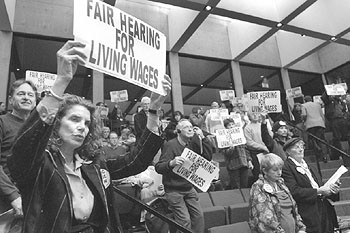Dead Wage
Is the living wage movement dead on arrival?
By Patrick Sullivan
They mobilized the troops. They packed the Santa Rosa City Council chamber with more than 100 sign-carrying supporters. And they negotiated frantically behind the scenes.
But despite the Sonoma County Living Wage Coalition’s impressive show of force, a living wage proposal was dead on arrival at last week’s Santa Rosa City Council meeting.
Led by Mayor Mike Martini, the council voted 4-3 against a motion by council member Noreen Evans to create a task force to study the proposal, which was brought to the council by the 40-member coalition.
Council member Sharon Wright cast the deciding vote against the task force proposal. “I think saying, ‘Go and study this and come back’ would be disingenuous on my part, because I just don’t think this is the role of local government,” Wright said.
The vote throws a big roadblock in the path of the living wage campaign, an ambitious effort that’s been two years in the making. But it also leaves coalition members pledging to continue the fight.
“I think it’s likely that we’ll be back sooner rather than later,” says Living Wage Coalition member Marty Bennett, a history instructor at Santa Rosa Junior College. “It’s just a question of when. This issue is not going to go away for the city of Santa Rosa.”
But Bennett and his allies, who also hope to bring a similar proposal before the Petaluma City Council, may have a tough fight ahead.
Council members who voted against forming a task force expressed some pragmatic reasons for their vote: Wright said she feared that the ordinance, which would mandate a wage of at least $15 an hour for most city workers and employees of firms that contract with the city, could result in fewer competitive bids on city projects and have an adverse impact on small businesses.
But many also express more fundamental criticisms of the concept. “I just don’t agree with the process, that we set the wages,” said council member Jane Bender.
To explain their vote, Bender and her colleagues also cited a list of 67 legal and practical questions posed by city staff about the ordinance. “I think it falls back on the shoulders of the coalition to answer these questions,” said Mayor Martini.
But Bennett doesn’t agree, noting that the wording of the coalition’s proposal is taken from living wage ordinance already in place in cities like San Jose. Some 70 municipalities across the country have adopted some form of living wage.
“Questions can be raised about any piece of legislation,” Bennett says. “But when the language you’re using has already been implemented elsewhere, one would think there was at least a solid foundation for going ahead with a task force.”
Bennett also argues that empirical evidence from other cities shows that council members’ fears are ill-founded: “There isn’t evidence elsewhere that small businesses suffer,” Bennett says.
The coalition meets next week to consider its plan of action, which may include a living wage ballot initiative. And Bennett says he’ll certainly be talking to Mayor Martini, who recently announced plans to run against U.S. Representative Lynn Woolsey in the upcoming Democratic primary.
“We had extensive discussions with him before [last week’s] meeting, and I really thought he was going to allow us to go forward,” Bennett says. “It could appear to many that he opposes a living wage by not even being supportive of a task force.”
From the December 13-19, 2001 issue of the Northern California Bohemian.











